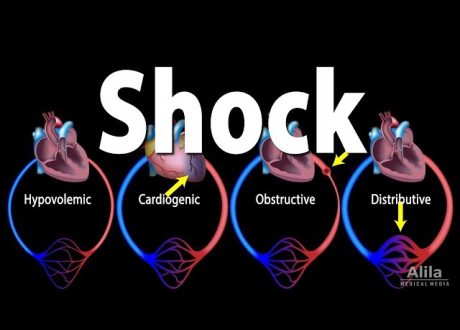Apatient in their 50s with a history of hypertension, chronic obstructive pulmonary disease, heavy alcohol use, and tobacco use presented to the emergency department with a 2-month history of nausea and vomiting that worsened in the 3 days prior to presentation to the point that the patient had been unable to tolerate anything by mouth. The patient denied chest pain or dyspnea. On arrival, the patient was afebrile with a heart rate of 129 beats/min, blood pressure of 70/48 mm Hg, and oxygen saturation of 94% on room air. Physical examination revealed nonlabored respirations with clear lung fields bilaterally, normal heart sounds with no appreciable murmurs, and warm and well-perfused extremities. There was mild tenderness to palpation of the epigastrium. Pertinent laboratory findings included a high-sensitivity troponin T of 0.008 ng/mL (to convert to μg/L, multiply by 1.0), lactic acid of 3.8 mmol/L, creatinine of 1.5 mg/dL (to convert to μmol/L, multiply by 76.25), and white blood cell count of 11 900/μL (to convert to ×109/L, multiply by 0.001). A 12-lead electrocardiogram (ECG) was obtained (Figure).

Questions: How would you interpret this ECG? What are some common causes of this ECG tracing?
Interpretation and Discussion
The 12-lead ECG revealed sinus tachycardia with ST depression in inferior and lateral leads (II, III, aVF, V4 to V6) and ST elevation of 2 mm in leads aVR and V1. This ECG pattern of significant ST elevation in aVR and V1 coupled with diffuse ST depression was once widely accepted to be an ominous finding suggestive of acute occlusion of the left main coronary artery or proximal left anterior descending artery that required emergent invasive assessment for revascularization.1 The 2013 ST-elevation myocardial infarction (STEMI) guidelines classified this pattern as a STEMI equivalent, necessitating immediate action and emergent timely transport either to a facility capable of left heart catheterization and percutaneous coronary intervention or thrombolytic therapy otherwise.2
In the current patient, cardiology was consulted to consider emergent left heart catheterization. In the interim, the patient was appropriately resuscitated with intravenous fluids with improvement in blood pressure to the 120s mm Hg systolic within 30 minutes from initial evaluation. A repeated 12-lead ECG was obtained at that time, which revealed normal sinus rhythm with complete resolution of all ST changes.
Further workup for the patient involved computed tomography imaging of the abdomen and pelvis that revealed gastric outlet obstruction secondary to a duodenal stricture, for which the patient underwent a successful robotic gastrojejunostomy later in the hospital course and was ultimately able to be discharged home. A transthoracic echocardiogram was notable for an ejection fraction of 60% to 65% and normal left and right ventricular systolic function with normal wall motion. Given the rapid resolution of ECG changes and lack of chest pain, further investigation with left heart catheterization was appropriately deferred, in turn avoiding any potential complications involved with the procedure, heparinization, or other treatments.
In the appropriate context, diffuse ST depression coupled with ST elevation in leads aVR and V1 can signify acute occlusion of the left main or proximal left anterior descending artery. In addition to acute occlusion of a coronary artery, diffuse subendocardial ischemia and repolarization abnormalities are important diagnostic considerations that can each in turn require vastly different choices in management.
In total there are 3 main categories to consider as underlying causes of ST elevation within aVR: occlusion of a coronary vessel, subendocardial ischemia, and repolarization abnormalities. Diffuse subendocardial ischemia can result from severe nonocclusive coronary artery disease (left main or 3-vessel) or from a demand/supply mismatch due to various causes, such as severe hypotension, sepsis, aortic stenosis, and uncontrolled hypertension. Repolarization abnormalities due to severe left ventricular hypertrophy or electrolyte abnormalities such as hypokalemia can also result in this ECG pattern.
In a study of more than 130 patients with ST elevation in lead aVR and diffuse ST depression, only about one-fourth of patients had acute coronary syndrome.3 In this patient, the rapid resolution of ECG changes after normalizing the blood pressure strongly suggests supply/demand mismatch from severe hypotension as the mechanism driving the initial presenting ECG changes. If instead the ECG changes had been secondary to either occlusion of the left main or left anterior descending artery, or instead due to significant nonocclusive coronary artery disease, the ECG findings would not have been expected to resolve with merely fluid resuscitation. Furthermore, there were no reversible causes of repolarization abnormalities identified to suggest that as the cause. This case helps put into perspective the importance of taking the entire clinical picture into account while also reinforcing the many differentials that can cause ST elevation within lead aVR.
While diffuse ST-segment depression with ST-segment elevation in aVR is an important indicator of a possible acute coronary syndrome, one must remain vigilant of the broad differential for this ECG pattern. Obtaining a complete history remains fundamental to providing the best care for patients.
Take-home Points
-
The ECG finding of ST elevation within lead aVR is no longer classified as a STEMI equivalent.
-
There are 3 main categories to consider as underlying causes of ST elevation within lead aVR: occlusion of a coronary vessel, subendocardial ischemia (from either severe nonocclusive coronary artery disease or from a demand/supply mismatch), and repolarization abnormalities.
-
Obtaining a complete history is fundamental to approaching a patient with ST elevation within lead aVR and determining the best course in patient care.
Corresponding Author: Michael Brouner, MD, Tinsley Harrison Internal Medicine Residency Program, University of Alabama–Birmingham Department of Medicine, 1802 Sixth Ave S, Birmingham, AL 35233 (mrbrouner@uabmc.edu).










